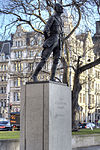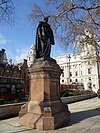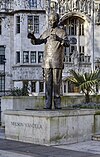
Brian William Haw was a British protester and peace campaigner who lived for almost ten years in a peace camp in London's Parliament Square from 2001, in a protest against UK and US foreign policy. He began the Parliament Square Peace Campaign before the September 11 attacks, and became a symbol of the anti-war movement over the policies of both the United Kingdom and the United States in Afghanistan and later Iraq. At the 2007 Channel 4 Political Awards he was voted Most Inspiring Political Figure. Haw died of cancer in Berlin, where he had been receiving medical treatment.

Cities of London and Westminster is a constituency returning a single Member of Parliament (MP) to the House of Commons in the United Kingdom Parliament. It is a borough constituency for the purposes of election expenses and type of returning officer. As with all constituencies, the election is decided using the first past the post system of election. Since its creation at the 1950 general election, the constituency has always elected the candidate nominated by the Conservative Party.

The Serious Organized Crime and Police Act 2005 is an Act of the Parliament of the United Kingdom aimed primarily at creating the Serious Organised Crime Agency. It also significantly extended and simplified the powers of arrest of a constable and introduced restrictions on protests in the vicinity of the Palace of Westminster. It was introduced into the House of Commons on 24 November 2004 and was passed by Parliament and given royal assent on 7 April 2005.

The Victoria Memorial is a monument to Queen Victoria, located at the end of The Mall in London by the sculptor Sir Thomas Brock. Designed in 1901, it was unveiled on 16 May 1911, though it was not completed until 1924. It was the centrepiece of an ambitious urban planning scheme, which included the creation of the Queen’s Gardens to a design by Sir Aston Webb, and the refacing of Buckingham Palace by the same architect.

The Buxton Memorial Fountain is a memorial and drinking fountain in London, the United Kingdom, that commemorates the emancipation of slaves in the British Empire in 1834, and in particular, the role of British parliamentarians in the abolition campaign.

Abby Jackson is a British artist, Stuckist painter, writer and art activist.
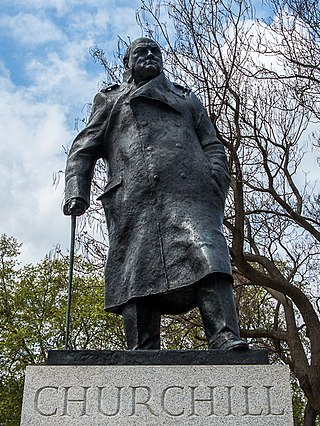
The statue of Winston Churchill in Parliament Square, London, is a bronze sculpture of the former British prime minister Winston Churchill, created by Ivor Roberts-Jones.

Nelson Mandela is a bronze sculpture in Parliament Square, London, of former President of South Africa and anti-apartheid activist Nelson Mandela. Originally proposed to Mandela by Donald Woods in 2001, a fund was set up and led by Woods's wife and Richard Attenborough after the death of Woods. The then Mayor of London Ken Livingstone obtained permission from Westminster City Council to locate the statue on the north terrace of Trafalgar Square, but after an appeal it was located in Parliament Square instead where it was unveiled on 29 August 2007.

The Parliament Square Peace Campaign was a peace camp outside the Palace of Westminster in Parliament Square, London, from 2001 to 2013. Activist Brian Haw launched the campaign at the site on 2 June 2001, initially as an around-the-clock protest in response to the United Nations economic sanctions imposed on Iraq. His protest grew broader following the war in Afghanistan and 2003 invasion of Iraq. He was joined by Barbara Tucker in December 2005, and stayed at the site day and night for nearly a decade.

A statue of William Shakespeare, by the sculptor Giovanni Fontana after an original by Peter Scheemakers, has formed the centrepiece of Leicester Square Gardens in London since 1874.
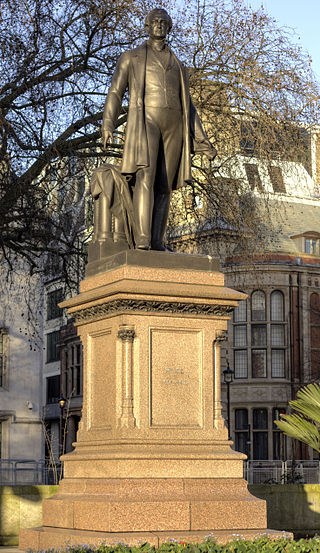
The statue of Robert Peel in Parliament Square, London, is a bronze sculpture of Sir Robert Peel, a former Prime Minister of the United Kingdom. It was sculpted by Matthew Noble and was one of the first three statues to be placed in the square.
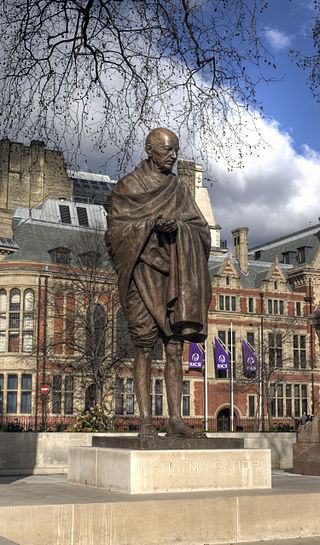
The statue of Mahatma Gandhi in Parliament Square, Westminster, London, is a work by the sculptor Philip Jackson.

The statue of Millicent Fawcett in Parliament Square, London, honours the British suffragist leader and social campaigner Dame Millicent Fawcett. It was made in 2018 by Gillian Wearing. Following a campaign and petition by the activist Caroline Criado Perez, the statue's creation was endorsed by both the Prime Minister of the United Kingdom, Theresa May, and the Mayor of London, Sadiq Khan. The statue, Parliament Square's first monument to a woman and also its first sculpture by a woman, was funded through the government's Centenary Fund, which marks 100 years since some women won the right to vote. The memorial was unveiled on 24 April 2018.
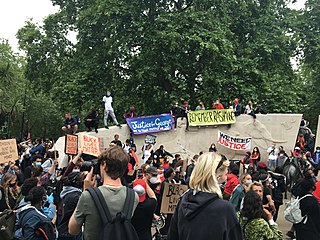
Protests were held across the United Kingdom following the murder of George Floyd, a 46-year-old African-American man, by a police officer in the United States on 25 May 2020. Immediately following his murder, protests and riots occurred in dozens of cities across the United States. Protests were staged internationally for the first time on 28 May, with a solidarity demonstration outside the United States Embassy in London. They took place during the UK COVID-19 pandemic.

A number of statues and memorials were the subject of protests and petitions during the George Floyd protests in the United Kingdom in 2020.






